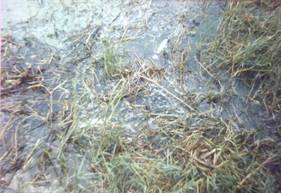RESULTS AND DISCUSSION |
Investigations of the various limnological parameters (Table 1) revealed the temperature around 28.5 ?C. The dissolved oxygen values varied from 1.6 to 2.4 mg/l. The lowest DO values were recorded in the inlet due to the heavy inflow of sewage at that point. These low values when compared with the optimum values for aquatic growth (5 to 6 mg/l) have contributed to mass death. pH (8.5 to 9) and alkalinity (448 to 492 mg/l) values reveal alkaline nature of the water body. pH and ammonia are critical factors in the survival of fishes and aquatic plants. As the photosynthesis progresses there is an increase in the oxygen values and decrease in the carbon dioxide levels in the water, accompanied with some rise in pH. Most adult fishes may not suffer from the adverse effect of high pH of 9 or more if exposed for a short period of 1-2 hours but young and juvenile fish are more susceptible to high pH. Total solids (a measure of total suspended and total dissolved solids) were high in all the locations ranging from 800-950 mg/l.
The eutrophic condition due to continuous inflow of sewage has led to profuse growth of algae. The lake water was turbid (>50 NTU) indicating increased concentrations of finely divided organic and inorganic matter, silt etc. Nitrate being consumed by algae is below detection limits. The concentration of phosphates ranged from 0.041 to 0.054 mg/l. The sodium (25.8 to 163.7 mg/l) and potassium (5.8 to 10.1 mg/l) values were high throughout the sampling points. Samples collected at all points tested positive for coliforms indicating the presence of faecal contamination. Higher values of physical, chemical and biological parameters clearly demonstrate that lake water is being polluted due to sewage, indicating the callousness of the administrators and civic authorities towards the proper treatment of urban waste. The common species of fish found in the Yennehole tank are Tilapia (Tilapia mossambica), Rohu (Labeo rohita), Mrigal (Cirrhinus mrigala) and catla (Catla catla). The livestock dependent on the tank were also severely affected as a cow died after consuming water from the tank.
The socio-economic study revealed that around 200 fishing families are dependent on this lake for their livelihood. The main fishing season in this lake is from April to May and this unexpected episode has affected fish harvesting during this peak period. The minimum catch per day is around 8 to 10 kg and the maximum catch is 100 kg. The fishermen earn Rs.6 per kilogram of fish when supplied to the Mysore Fishery Federation.
The episode of fish kill and other environmental problems highlight the need for a holistic and integrated approach to the sustainable management of ecosystem. Unplanned urbanisation coupled with improper, disintegrated and piece-meal approach adopted by the present day civic authorities and administrators are the root cause of most of the problems, which has led to degradation of the environment. Lack of proper sanitation and treatment options has converted most urban areas in to unhygienic places for breeding vectors (mosquito, etc.).
Water is used for a variety of purposes. The management aspects have to be viewed from the types of uses and the possibilities of loss of resource quality and quantity during the utilization process. Fish and fisheries are an intrinsic part of the lives of a major percentage of the population in all parts of the globe. So maintenance of the quality of the water bodies becomes a priority in the restoration measures. Freshwater fish comprise about one-third of all fish species. Since lakes are lentic systems, fish have no means of escaping from their deterioration, and are therefore vulnerable to ecosystem differences. Routine monitoring and reporting on the water quality and habitat conditions should be conducted with the involvement of local groups, schools, colleges and technical experts, and specific environmental quality criteria should be maintained to ensure the health of the ecosystem and its inhabitants. Active monitoring should be undertaken for predicting the likelihood of occurrence of similar events in the future. Appropriate physico-chemical parameters along with plankton and microorganisms should be analysed at regular intervals. The sampling and analyses should be carried out monthly or bi-monthly, although the latter is preferable.
Ancient scripts and most religions strongly advocate the necessity of sustainable water management strategies and their implementation. However, the present policy makers with fragmented approaches and a narrow vision are converting most of the ecologically sensitive regions, urban areas into slums (to garner votes!) and continuously encourage the encroachment of public areas (parks, tank beds, common lands, etc.).
Major pollutant in Yennehole tank is sewage from the surrounding urban areas. The sewage must be treated properly before being let in to the water body. Most of the lakes in urban areas have become cesspools. This demands an appropriate, timely decision and sincere implementation to restore the quality of the water body. Constructed wetlands can be used for the treatment of sewage, which involves the use of engineered systems that are designed and constructed to utilise natural processes. They are designed to mimic natural wetland systems, utilising aquatic plants, soils and their associated microorganisms to remove contaminants from sewage. Use of treated sewage provides an opportunity to successfully restore valuable wetland habitat for numerous uses (aquatic flora and fauna, wildlife, etc) and environmental quality enhancement. Although selfish human beings can render the whole exercise futile. The contaminated sediment should be removed from the water bodies, which can be used for building bunds and islands with appropriate treatment. The Madivala and Hebbal tanks in Bangalore are some examples of successfully restored wetlands, where the water quality has improved significantly along with biodiversity and the health of the local ecosystem.
Sustainable management strategies should include

Fig 1 : Polluted lake on eastern side

Fig 2 : Weeds, weeds everywhere